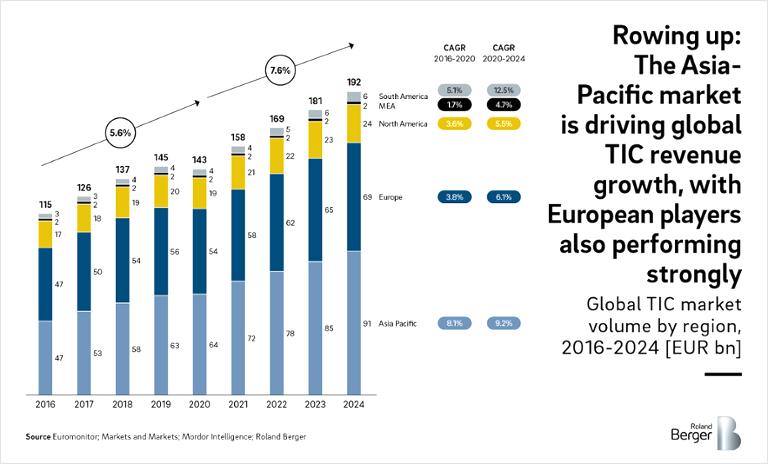Roland Berger helps companies deal with global crises (Ukraine war, inflation, interest rate hikes and Covid) and makes them fit for the future.


Quality assured? A customer survey on the testing, inspection, and certification industry
By Niko Herborg and Benedikt Rickmers
A customer-focused market survey of challenges, growth and customer needs – and how TIC players can meet them
The global TIC industry is growing strongly, with an average growth rate of 7.6% until 2024. But it faces a series of mega trends that threaten to knock it off track if players fail to act. Roland Berger surveyed five major TIC segments to determine future growth expectations, identify customer needs and highlight key target areas.

"TIC industry faces significant long-term challenges with a good potential for small and agile players to gain market share."
As the world develops and changes, the business world develops and changes with it. The quality assurance – or testing, inspection and certification (TIC) – industry makes sure it does so safely, sustainably and in compliance with regulations. From quality control to compliance, manufacturing standards and medical testing: TIC players help to ensure goods and services are reliable and fit for purpose.
Like many other industries, the global TIC market took a big hit outside Asia & Pacific in 2020 due to the COVID-19 pandemic. While the post-COVID recovery has already started, the trends driving the market differ significantly from the pre-COVID world. In order to see what the future holds for the industry, Roland Berger conducted a market assessment and survey of five major TIC segments to identify the needs of customers and the action required by TIC players to overcome future challenges. The key results are presented in the accompanying executive summary and outlined in this article.
Market outlook
After COVID, the global TIC industry continues to show solid growth prospects. The market volume is forecasted to rise from EUR 143 billion in 2020 to EUR 192 billion in 2024, with an average growth rate of around 7.6% in the same period. While for many European TIC players Europe is the most important market, Asia Pacific continues to be largest overall TIC market, with rapid industrialization in the infrastructure, energy and transport sectors (especially in China and India) generating considerable opportunities for TIC services. South America, the second smallest TIC market behind the Middle East and Africa, will grow the fastest, at a rate of 12.5%. Overall growth predictions for the TIC market are further in line with past performance, at around 3% above GDP growth.
Most European TIC players experienced growth of 0-4% between 2016 and 2021, recovering quickly from the COVID-related dip in 2020. Eurofins, headquartered in Luxembourg, stood out with extraordinary revenue growth of around 22%. This was driven by extensive M&A activity and its focus on medical – and especially COVID-related – testing services. Its EBIT margin also soared, reaching 19% in 2021. While keeping up with most competitors in terms of revenue growth, German players were less profitable.
"TIC companies are continuously faced with the challenge of serving local markets effectively and efficiently in a global environment. I am convinced that this study provides relevant and new insights into the customers' perspective."
Challenges & trends
Despite the growth achieved in the past few years, TIC players face significant long-term challenges in addition to short-term profitability issues. Roland Berger has identified eight mega trends that are already impacting or will impact the industry in the near future:
Supply-chain liability: While companies are becoming more and more liable for their whole downstream supply-chain, complexity increases as a result of fully interconnected supply chains.
Penetration of digitalization: Relevance of B2C and B2B digitalization (IOT, data analytics etc.) will increase, threat of cyberattacks is rising and digitalization of TIC processes will continue.
Sustainability, ESG and climate change: Growing regulatory pressure for significant greenhouse-gas reductions (CO2, methane, etc.) and the decarbonization of entire business models.
Technological progress: A never-ending pipeline of new and more advanced products and services require TIC services, while at the same time life cycles between innovations are shortening.
Regulation: Regulatory requirements, especially in European markets, around a product or service’s quality, sustainability and safety are tightening.
Change in market structures: Consolidation in the TIC industry is ongoing and a trend towards privatization of services rather than ownership/contracting by public organizations is observable.
Demographic changes: Increasing urbanization, growing youth populations in emerging economies and aging populations in industrialized countries are shaking up established demographic norms.
Population growth: The global population is rising, with significant over-population in Asian and African countries.
Survey results
To determine what customers demand and what TIC players need to do to overcome named challenges, Roland Berger’s survey targeted five key TIC segments: Automotive & mobility; Building & construction; Consumer goods & electronics; Food & agriculture; and Life science & healthcare. Participants were B2B TIC service customers from a broad spectrum of industries (for example, retail, automotive, consumer goods).
Questions focused on four key areas: Growth expectations (overall TIC sector in next three years); Trends impacting growth (growth drivers); Most relevant service offerings (what services customers demand); and most important purchasing criteria (what providers need to offer). Below is a summary of the outlook and key results for each segment.
Automotive & mobility
The growth outlook in the segment was neutral, with only 46% of respondents expecting increasing demand for TIC services. The key growth driver was quality improvements, with regulation and outsourcing less important.
The most-demanded TIC services were “Vehicle type approval” and “Statutory vehicle inspection”, while the emergence of new technologies, especially in e-mobility, where fewer inspections are required, led to the overall reduced growth expectation.
Building & construction
The segment had a very positive (84%) growth outlook for TIC service demand. Regulation was seen as a clear driver for growth, with new trends such as sustainability increasingly adding to regulatory requirements.
“Materials testing and certification” and general “Fire testing” services were the most relevant TIC offerings. Regulation around sustainability and safety requirements was expected to drive industry demand, in particular.
Consumer goods & electronics
In Comparison, the segment had the lowest growth outlook, with only 35% of respondents expecting further increasing demand of TIC services. Quality improvements were the main driver for demand growth.
The most relevant services were “Connectivity and electronic device testing” and “Microelectronics quality control”, both of which require digital and technological capabilities from TIC service providers.
Food & agriculture
The overall outlook in the segment was positive (63%), with food regulations expected to be the main growth driver for TIC service demand.
Reflecting this, “Food testing and certification” and “Food microbiology testing” were the most relevant TIC services. Food-related TIC service growth is driven mostly by the growing population and sustainability trends.
Life science & healthcare
The outlook for both overall segment demand (83%) and own demand within the segment was very positive. This is attributable to the very high level of regulation in the industry, which is expected to continue to be the main driver for TIC service demand. Furthermore, post-COVID, medical testing services have significantly gained relevance.
The further growing relevance of TIC services for medical devices was reflected in the results, with “Biocompatibility” and “Materials testing for medical devices” the top two most relevant TIC services. Growth was predicted to be driven mostly by regulation, as well as technological progress.
For fuller results and analysis, please see the accompanying executive summary. And please do not hesitate to get in touch if you have any questions or comments. We are happy to discuss interpretations and implications of the study.
Register now to download the full study on “The future of the TIC industry” including key insights from our survey, as well as our suggestions for players in the TIC industry. Additionally, you get regular insights into required actions of future challenges.



_person_144.png?v=822340)



